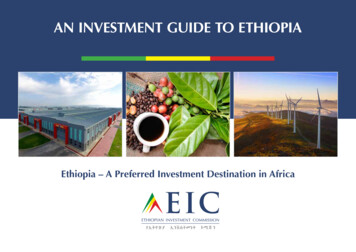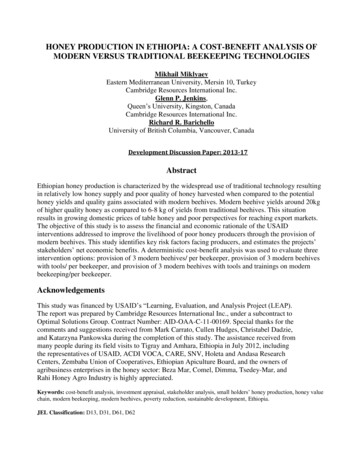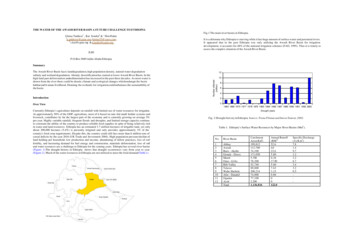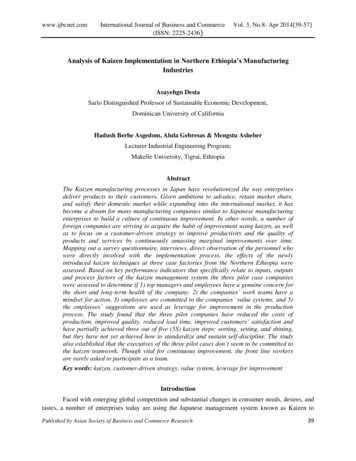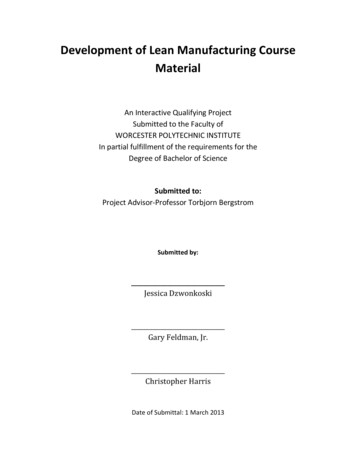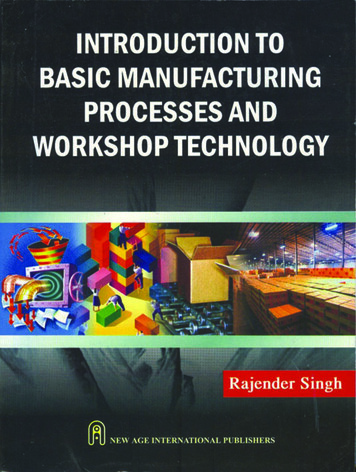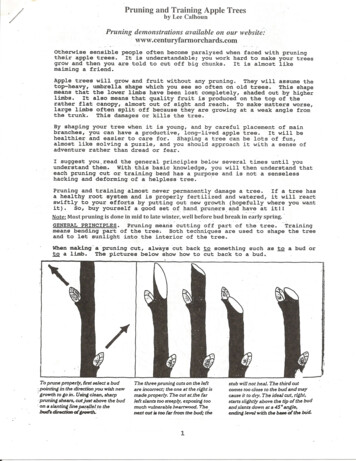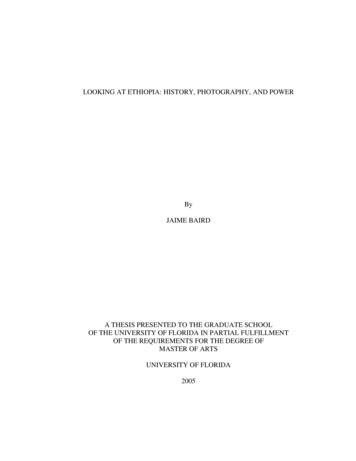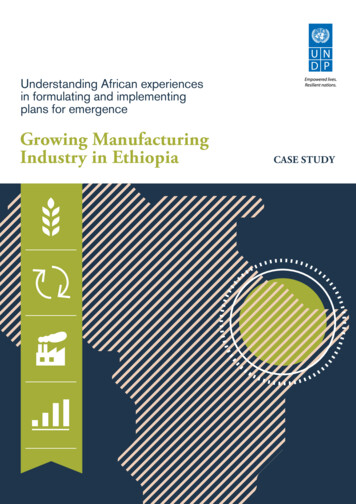
Transcription
Understanding African experiencesin formulating and implementingplans for emergenceGrowing ManufacturingIndustry in EthiopiaCASE STUDY
cementsugarchemicalpharmaceuticalmetaltextile, leather taltextile, leather produfertilizer
Understanding African experiencesin formulating and implementingplans for emergenceGrowing ManufacturingIndustry in EthiopiaCASE STUDY
Table of ContentsAbbreviations. viiAcknowledgments. viiiExecutive Summary. ixChapter 1: Introduction . 1Chapter 2: National Plan forEmergence in Ethiopia. 52.1. The Plans.62.2. Growth Performance and Structural Change UnderPASDEP and GTP I .122.3. Social Development .22Chapter 3: Institutional Setup. 253.1. Core Government Institutions.263.2. Specialized Institutions.273.3. The Participatory Process.27Chapter 4: A Critical Evaluation of thePerformance of the National Plans. 294.1. The period of policy trial (1995 – 2004).304.2. PASDEP: An Episode of Demand DrivenHigh Economic Growth.314.3. GTP: A Test to an Economic Take off.31Chapter 5: The Manufacturing Sector: Movingthe Hard Wheels for Emergence. 355.1. Evolution and State of the ManufacturingSector in Ethiopia.365.2. Lessons from Challenges to the Manufacturing Sectorduring GTP I.375.3. GTP – II and its Strategy Towards Industrialization.405.4. Potential Challenges Ahead.43Chapter 6: Conclusion and Lessons Learnt. 45A CASE STUDY OF GROWING MANUFAC TURING INDUSTRY IN E THIOPIAv
List of TablesList of FiguresTable 1:Major investment projects of the GTP. 8Figure 1: Trends Emergence. 3Table 2:Major Macroeconomic Targets of the GTP – I(2009/10-14/15). 9Figure 2: Growth in GDP by plan period.12Table 3:Major Macroeconomic Targets of the GTP – II(2015/16-19/00).11Table 4:Major export targets (as per cent of GDP).11Table 5:Industrial Parks.42Figure 3: Trends in average per capita GDPgrowth (per cent).13Figure 4: Trends in the factor contribution to growth (fiveyear moving average of percentage points).14Figure 5: Patterns of the long-run and short runcomponents of per capita GDP.14Figure 6: The association between cyclical component ofper capita GDP and rainfall.15Figure 7: Signs of capital deepening: rising capital – laborratio and capital – output ratio.16Figure 8: Dynamic contribution of sectors to GDP.17Figure 9: Dynamic contribution of subsectors of theindustry sector to GDP growth.17Figure 10: Demand side decomposition of growth.19Figure 11: Contribution of components ofdemand to growth.20Figure 12: Trends in gross fixed investment, grossdomestic saving and net current transfers.20Figure 13: Trends in export and imports.21Figure 14: Change in the sectoral distribution oflabor (2005-2013).21Figure 15: Change in the sectoral distribution oflabor (2005-2013).22Figure 16: Trends in net enrollment ratio (Grades 1-8).23Figure 17: Trends in net enrollment ratio (Grades 9-10).23Figure 18: Trends in HDI.24Figure 19: Constraints in the manufacturing sector inEthiopia as ranked by responding firms.39viA CASE STUDY OF GROWING MANUFAC TURING INDUSTRY IN E THIOPIA
AbbreviationsADLIAgriculture Development – Led IndustrializationIAIPsIntegrated Agro – Industrial ParksCADUChilalo Agricultural Development UnitIFPRIInternational Food Policy Research InstituteCSACentral Statistical AgencyIPDIndustrial Parks DevelopmentDPPCDisaster Prevention and Preparedness CommissionIPDCIndustrial Parks Development CorporationMDGsMillennium Development GoalsDBEDevelopment Bank of EthiopianEEPAEthiopian Export Promotion AgencyEIAEthiopian Investment AgencyEICEthiopia Investment CommissionEPRDFEthiopian Peoples’ RevolutionaryDemocratic FrontMETEC Metal and Engineering CorporationMOFEC Ministry of Finance and Economic CooperationMOFED Ministry of Finance and Economic DevelopmentNPCNational Planning CommissionPASDEP Plan for Accelerated and Sustained Development to End PovertyESSPEthiopia Strategy Support ProgramFDREFederal Democratic Republic of EthiopiaGDPSDPRPSustainable Development and PovertyReduction ProgramGross Domestic ProductTFPTotal Factor ProductivityGERDGreat Ethiopian Renaissance DamUNDPUnited Nations Development ProgrammeGTPGrowth and Transformation PlanUNECA United Nations Economic Commission for AfricaA CASE STUDY OF GROWING MANUFAC TURING INDUSTRY IN E THIOPIAvii
ewordThis study was presented at the second edition of the International Conference on the Emergence of Africa (ICEAII) from 28th to 30th March 2017, in Abidjan, Cote d’Ivoire.The conference was jointly organized by United NationsDevelopment Programme (UNDP), and the Governmentof Ivory Coast and in partnership with the World Bank andthe African Development Bank (AfDB) under the theme“IMPLEMENTATION OF PLANS FOR EMERGENCE IN AFRICA.The ICEA is an opportunity for selected countries on thepath of structural emergence, to share experiences anddraw lessons from best practices in order to accelerategrowth and structural transformation of their economiesfor the wellbeing of their people.Special tribute goes to the organizers of the ICEA for selecting Ethiopia as one of the countries to share its rich anddiverse experience on the growth of manufacturing industry. Ethiopia has over the past decade achieved strongand robust economic growth coupled with the expansionof social services. Current efforts are directed towards sustaining double-digit growth episodes by deepening structural change in the economy and visioning to become alower middle- income country by 2025. The country’s midterm plan (GTP II) underscores emergence in the form ofdesirable outcomes of structural transformation in a relatively shorter period of time by redirecting activities tohigh productivity sectors, in particular, the manufacturingsector. Industrialization is accepted as the only viable wayof ensuring structural transformation. Industrializationand ensuring emergence with an active role of the statehas been in place since 2011 with the launch of the firstgrowth and transformation plan (GTP). The ICEA provideda platform for Ethiopia to share its experience and UNDPEthiopia would like to thank the UNDP Regional Bureaufor Africa (RBA), under the leadership of Mr. AbdoulayeMar Dieye, Director of the Regional Bureau for Africa, andMr. Ayodele Odusola, RBA Chief Economist for the supportand guidance provided throughout the formulation anddrafting of this study.This report was prepared under the stewardship of thePolicy Advisory Unit team led by Mr. James Wakiaga,Economics Advisor, UNDP Ethiopia and Mr. Haile Kibret,National Economist, with the leadership, guidance andsupport from Ms. Ahunna Eziakonwa- Onochie, UNDPResident Representative and UN Resident Coordinator inEthiopia and Mr. Samuel Bwalya, UNDP Country Director.Special mention goes to our independent consultant Dr.Seid Nuru, who tirelessly worked with PAU team in conducting the study. The report has benefitted from a widerange of reviewers whose contribution enriched the casestudy, this includes, the UNDP Ethiopia Policy AdvisoryUnit (PAU) team, RBA Strategic Policy Advisory Unit team,Regional Bureau for Africa, RBA Economists who have provided extensive comments as well as valuable commentsfrom National Planning Commission of Ethiopia, justto mention a few.This report is showcasing the achievements of the countryembarking on transforming its economy via the industrialsector particularly in the light manufacturing sub sector.The report will serve as a pivotal reference document topolicy makers and planners within Government, the privatesector, academia, development partners and civil society.Ahunna Eziakonwa-OnochieUNDP Resident RepresentativeAhunna Eziakonwa-OnochieUNDP Resident RepresentativeviiiA CASE STUDY OF GROWING MANUFAC TURING INDUSTRY IN E THIOPIA
Executive SummaryEthiopia has embarked on a transformational journey ofbecoming a low middle-income carbon-neutral economy by 2025. To attain this goal, Ethiopia needs to sustainthe high growth episodes that have been observed overthe last decade by deepening structural change in itseconomy. The Second Growth and Transformational Plan(GTP II) (2015/16-2019/20) envisages an emergence in theform of desirable outcomes of structural transformation in a relatively shorter period of time as in the case ofSouth East Asian countries. This is to be achieved by shifting economic activities from low productivity to high productivity sectors, especially in the manufacturing sector.The pursuit for industrialization is the most viable optionfor ensuring structural transformation.The current policy response for industrialization throughthe State’s active role has benefitted from the country’slong- held tradition and experience of planning over several decades, evident since 2010/11 with the launch of thegrowth and transformation plan (GTP). Planning in Ethiopia began as early as 1945 when a ten year industrial strategy was elaborated. A formal five – year development planwas launched in 1957 during the Imperial Governmentof Ethiopia with the major objective of laying foundationfor an economic take-off.The first five year development plan (1957 – 1961) focused on infrastructure, human capital formation (education), and resource mobilization. The second five yeardevelopment plan (1963 – 1967) which was part of adevelopment plan with a target to double income in 20years gave priority to the industry sector in particular theagro-processing industry, mining, and power generation.With the active intervention of the Imperial Government,the manufacturing sector grew at an annual average rateof 16 per cent thus pushing the share of the industrialsector from 9 per cent to 13 per cent during the planningperiod. Most importantly, the monetized sector expandedby 5.7 per cent per annum. The third five- year development plan (1968 – 1973) gave more emphasis to the agriculture sector in order to fill the gap in raw materials anddomestic demand for industrial outputs that emergedduring the implementation of the second five- year development plan. The active interventions of governmentin commercial agriculture across major agro-ecologicalzones of the country served as a basis for surplus production in the sector.Discontent among the youth elite in the land tenure system, coupled with emergence of features of socialism inthe world politics subsequently deposed the Imperial regime through a military takeover. Planning gained morecurrency during the socialist regime. Nationalization ofmajor agricultural industrial capabilities, forced quota deliveries, and collectivization as demanded by socialist dogmas replaced market principles of self - interest with virtue. The unpopular policies coupled with civil and regionalwars led to the malfunctioning of the economy: per capitaGDP was declining at a rate of 1.4 per cent per annum overthe 17 years reign of the regime (1973/74 – 1990/91).Market economy was restored in the country after theincumbent Ethiopia People’s Revolutionary DemocraticFront (EPRDF) government took power in 1991. In 1995,a policy of agriculture development led industrialization (ADLI) was introduced. Agriculture used to accountfor more than 50 per cent of the GDP and about 90 percent of the export earnings. Moreover, 85 per cent of thepopulation was engaged in the subsistence agriculture.Such a structure of the economy justified ADLI’s officialbias in favor of rural development. Important focus areasduring the early years of the first GTP were food security,education and infrastructure.Ethiopia’s experience in the last two decades has demonstrated that emergence is a process where sequencingand smart prioritization of policy targets is critical. Thereis a need to understand that development processesare iterative where past experience informs the present.Pragmatism in approaches to development and seekingalternative paradigms becomes key. In all these, the roleof the state is crucial. The series of development plans produced over the last two decades demonstrated how everynew plan was built on the lessons of the previous plan. In2003, a three – year development plan entitled – “Sustainable Development and Poverty Reduction Program(SDPRP) was launched to mainly pursue the tenets of theADLI policy. As a result, SDPRP gave more emphasis to ag-A CASE STUDY OF GROWING MANUFAC TURING INDUSTRY IN E THIOPIAix
E X E C U T I V E S U M MA R Yriculture, education, and infrastructure development. Thecountry recorded a GDP growth rate of 5.9 per cent duringSDPRP. In comparison to a population growth rate of 2.9per cent during the same period, the growth observed under SDPRP was not enough to lift many people out of thequagmire of poverty.One major gap during the implementation of SDPRP wasthe apparent neglect to the demand side of the economy,in particular the urban sector. Periods of bumper harvestin the agricultural sector were characterized by low priceswhich in turn became disincentives to surplus production.A new development plan entitled “Plan for Acceleratedand Sustained Development to end Poverty (PASDEP)was introduced in 2005. The new plan built on the prioritysectors that were identified in the SDPRP. The focus givento urban development was a new commitment. Public investments in social and economic infrastructure in majorurban centers and private investment in the constructionsector augmented demand in the urban centers significantly. Agriculture responded to the rise in demand inhigh growth. Overall, real GDP grew at an average annualrate of 11 per cent over the five- year plan period. Serviceand agriculture sectors led the growth momentum, having contributed 55 per cent, and 36.6 per cent, respectively, to the 11 per cent growth in GDP. That is, out of the 11per cent growth in real GDP, 6 percentage points, and 4percentage points were the shares of the service, and agriculture sectors, respectively.Two major legacies of PASDEP were the high growth thatwas robust enough to have slashed poverty significantly(from 38.7 per percent in head counts ratio in 2005 to 29.6per cent in 2011), and the inspiration that the country waswell positioned to now emerge as a viable economic power.In fact, the proportion of people below the poverty line in1996 was 45.5 per cent. Nevertheless, the record high inflation that had accompanied the high economic growth appeared to have shown a limit to the public investment - leddemand driven growth. By the end of the PASDEP period,it was realized that the high growth episode that had beenachieved during PASDEP could only be sustained throughdeepening of structural change, by prioritizing the role ofmanufacturing sector in the national economy. In particular, the manufacturing sector was is expected to play acatalytic role in driving the growth momentum, employingfactor inputs (mainly labor), and changing the structure ofthe export which was dominated by agricultural primarycommodities. In a nutshell, structural transformation beyond an episode of high income growth became critical. Asa result, the first growth and transformation plan (GTP)was in place by 2010/11 with the aim of laying the foundation for structural transformation.In the first Growth and Transformation Plan, the economywas projected to grow at an average annual rate of 11 percent over the five year plan period (2010/11 – 2014/15). Asthe private sector was perceived to have inclined towardthe service sector with quick returns, the government decided to invest strategically in the manufacturing sector.xSugar, fertilizer, metallurgy, chemical, pharmaceuticals,and cement industries were among the strategic areasthat the Government planned to invest 11.5 billion overthe planned period. Cognizant of the major infrastructural bottlenecks to implement the targets on investment inthe manufacturing industry, the plan had also targetedmajor investments on economic infrastructure such asenergy, road, railway, and telecommunication, with a totalplanned investment of 21.3 billion. The energy projectwas planned to increase the nation’s total energy generation form 2,000 MW in 2010/11 to 10,000 MW in five toseven years’ time and this was envisaged to increase theelectricity access coverage from 41 per cent to 75 percent. The plan on the railway construction aimed to meetmass transportation needs with a coverage of 2,395 kmrailway stretch line. The 34 km Addis Ababa light railwaytransit project was part of the plan for mass transportation. The Addis Ababa condominium integrated housingproject was designed to curb the rampant housing problem in the city and to encourage the practice of savingfor low income earners. Moreover, about 70 per cent ofthe total government budget was allocated to projectsrelated to poverty reduction such as education, health,roads, water and sanitation, agriculture and food securityamong others.The performance of the GTP had mixed results. RealGDP grew at an average rate of 10 per cent over the fiveyear period against a target of 11 per cent. Largely owingto the condominium housing project, the Great Renaissance Dam Bond, expansion of financial services throughthe branch network drive and other modalities of domestic resource mobilization, domestic saving rates increasedfrom 9.5 per cent of GDP in 2009/10 to 21.8 per cent ofGDP in 2014/15., Gross fixed investment rose from 22.3per cent to 39.3 per cent of GDP in the same period. Investments made in the social sectors such as educationand preventive health care systems yielded encouragingresults in the form of high enrollment ratio in all levels ofeducation and decreased rates of infant and under-fivemortality. Modest performances have been observed inthe infrastructure development with delays in some projects due to financial constraints. Nevertheless, the targetof deepening structural change was challenged due todelays of investment projects in the sugar and fertilizer industries. The delay in these key projects coupled with thefall in international commodity prices added stress to theforeign exchange earnings of the country at the criticaltime when capital imports were expected to rise.The implementation of GTP I revealed important gapsin the key goal of structural change. Fundamental problems included limited domestic technological capability,lack of institutional transformation, and limited readiness for industrialization in the area of infrastructure, andstrong inertia of social duality with entrenched customs inthe rural sector.Leaving possibilities of rent seeking tendencies aside, oneplausible explanation for the delay of the key projectsA CASE STUDY OF GROWING MANUFAC TURING INDUSTRY IN E THIOPIA
E X E C U T I V E S U M MA R Yin the manufacturing industries, for instance, is the gapin the domestic capacity in terms of skill and technological know-how. The rationale behind awarding suchcomplex projects to domestic contractors was to understandably build national capacities in industrial engineering. However, the planners should have foreseen the longlearning curve required to assimilate to new technologyas it contains elements of explicit (coded) and tacit (uncoded) knowledge where the latter is difficult to transfer.Ethiopia has a strong culture of agriculture. Industrialization is a new culture the country is embracing in a relatively short period of time. Specific problems in the manufacturing sector include foreign exchange constraintsto imports, intermittent power interruption and limitedaccess to electric energy, shortage and irregular supply ofdomestic raw materials due to weak linkages, limited access to and poor quality of internet services, and weak logistical support that leads to high transaction costs. Theseand other associated constraints contributed to limitingthe average capacity utilization of the medium and largescale manufacturing industries at 67 per cent. The answersto the whys of these problems may still point to the morefundamental problems such as weak institutions.The second GTP (GTP II) was launched in 2015/16 as acontinuation of the plan that preceded it to deepen structural change in the country by redressing the challengesencountered during the implementation of GTP I. Theplan has identified key elements of structural transformation at macroeconomic level. These include high economic growth, high rate of capital accumulation, structural change, macroeconomic stability, and institutionaltransformation. It envisages 11 per cent average annualeconomic growth rate, domestic saving rate to increasefrom 21.8 per cent to 29.6 percent, gross fixed investmentfrom 39.3 per cent to 41.3 per cent, value of exports asper cent of GDP from 9.8 per cent to 20.6 per cent, andresource gap to reduce from 17.5 to 11.5 per cent of GDPin the plan period of 1915/16 to 2019/20.A sizeable component of the 11 per cent growth is to emanate from the industrial sector. The main objective ofthe industrial development strategy is to ensure thatthe manufacturing industry becomes the main driver ofgrowth to accelerate the structural transformation in theEthiopian economy in general and be a source of productivity, export earnings, a medium of technological transferfor overall technological capability, and a source of employment in the changing rural – urban demographic balance in particular.The new policy drive towards manufacturing sectordevelopment is anchored on a number of imperativesaimed at increasing productivity, quality and competitiveness among both existing and upcoming manufacturingindustries; investing in labor intensive light manufacturing industries with global standard of quality and efficiency; increasing the capacity of industrial engineeringtechnology; and diversifying the country’s export towardslight and heavy manufacturing.The plan targets an average growth rate of 20 per centper annum of an industrial output in value-added termsover the five year plan period and increases the staticshare of the industrial sector in the GDP from 15.1 per centin 2015 to 22.3 per cent by 2020. In particular, the manufacturing sector is envisaged to grow annually at a rate of21.9 per cent during the same period.The successful implementation of such an ambitious plandemands serious engagement between the government, the private sector, and other stakeholders inaddressing the major bottlenecks constraining thesector. Under GTP II, industrial parks development andregional cluster development for small and medium scaleenterprises are the two major modalities or approachesdesigned to curb the constraints associated with the domestic capacity in industrial technology.The strategy of industrial parks development which isbeing implemented by the Industrial Parks DevelopmentCorporation (IPDC) has a purpose of attracting foreigndirect investment (FDI) in key strategic manufacturing industries, which in turn, would assist transfer technologyto the local entrepreneurs, diversify the structure of thecountry’s export, and generate employment. The IPDC,which has the vision of becoming an “innovative andleading eco-industrial parks developer and operator in Africa by 2025,” is mandated to activate both pre and postinvestment servicing, availing land, and pre-built shedsequipped with all-encompassing utilities and infrastructural facilities with international standards of quality ofservice, labor security, and environmental safety.About 12 industrial parks for export processing, havebeen identified across the country based on proximity to market outlets, infrastructure, economicpotential, and regional balance in development. Almost all industrial parks are established along corridorsof railway networks that are either completed or underconstruction and are on schedule. The construction oftwo major industrial parks in Addis Ababa and Hawassahas been completed with nine firms having started production in Addis Ababa and all sheds having been occupied in Hawassa.The regional cluster for the development of small andmedium scale enterprises has the goal of basing thelong- term industrialization program on indigenouspeople. The program targets the youth, in particular,graduates from technical schools and colleges and provides them with financial and technical support in clustersheds along the various regional states to start up smallscale manufacturing industries. This project has the objective of inculcating the culture of industrialization amongthe youth and harnessing the future industrialists throughlearning by doing at a shop floor level. A compulsory graduation from small scale enterprises by each entrepreneurimplies a vision for firm growth. The Development Bank ofEthiopia (DBE) will be responsible for supplying the loanrequirement of the projects.A CASE STUDY OF GROWING MANUFAC TURING INDUSTRY IN E THIOPIAxi
E X E C U T I V E S U M MA R YIn addition, a project on micro and small enterprisedevelopment is being developed to directly addressthe challenge of urban unemployment. This projectis complemented with an urban safety net program targets the urban poor to generate their own income fromsmall businesses.The input constraints due to high import prices for rawmaterial and inadequate supply of domestic raw materials due to weak agricultural – industrial linkages are tobe addressed through various input policies. In responseto such weak linkages, the Government of Ethiopia plansto establish integrated agro-industrial parks (IAIPs)along the major agro-ecological zones of the country.The parks are aimed at attracting private investors to setup food processing plants, reducing post-harvest losses,adding value to local content of food, linking farmers inclusters to food manufacturing plants, securing forwardlinkages for the processed produce, and creating jobsand driving rural economic growth in the country. Complementing the goals of IAIPs with the aims of GTP II tolink rural areas with road networks and making financialservices accessible to rural areas in order to facilitate ruraltransformation, with changes in preferences and choice oftechnology by the rural people.The problem of power shortages and electric powerinterruption is expected to be addressed once and forall when the Great Ethiopian Renaissance Dam (GERD)project is complete and begins the production of 6,000MW electricity at full capacity. , The on-going project ofupgrading the old transmission and distribution lines ofxiielectric power and once completed will also address theproblems. In the meantime, the recent completion of theGhibe III hydroelectric dam with the capacity of 1,870MW is equally expected to relieve the constraints in electric power sector.The Government of Ethiopia has made it clear that goodgovernance is fundamental to the successful completionof the various development goals and targets. In fact,building sound institutions is critical to a modern economy that Ethiopia is envisaging to become. The institutionaltransformation will be one of the key challenges under theGTP II. The country needs to build a national consensus onthe notion that corruption is the worst form of exclusion.Given that 73 per cent of the population is still engagedin subsistent agriculture, agricultural transformationand preparedness for sustainable urbanization withsmooth rural – urban migration remains to be one of thecritical challenges of the development process. The migration of people from the rural areas to the urban centersand hence the expansion of urbanization becomes inevitable. The challenge is how to make it sustainable in theface of many challenges and new demands.Ethiopia may find it critical to reform the labor market insuch way that accountability is imminent; hard work,educational preparedness and excellence are rewarded. Discriminating in returns in the form of wages and salaries and other incentives in key sectors would increasecompetence and discourage rent seeking from being adominant strategy.A CASE STUDY OF GROWING MANUFAC TURING INDUSTRY IN E THIOPIA
E X E C U T I V E S U M MA R YA CASE STUDY OF GROWING MANUFAC TURING INDUSTRY IN E THIOPIAxiii
1C H A P T E R 1: I n tr o d ucti o ltextile, leather prodfertilizer1A CASE STUDY OF GROWING MANUFAC TURING INDUSTRY IN E THIOPIA
C H A P T E R 1: I n tr o d ucti o nAfrica’s dependence on the production of prima
viii A CASE STUDY OF GROWING MANUFACTURING INDUSTRY IN ETHIOPIA This study was presented at the second edition of the In-ternational Conference on the Emergence of Africa (ICEA II) from 28th to 30th March 2017, in Abidjan, Cote d'Ivoire.
